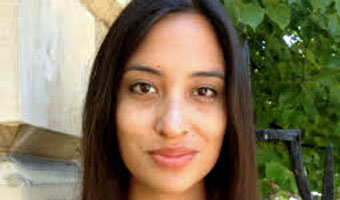By Kristin Distel
Dr. Myrna Perez Sheldon, Assistant Professor of Classics & World Religions and Women’s, Gender & Sexuality Studies, is currently serving on an advisory board with the Smithsonian National Museum of American History.
She is one of approximately 10 scholars whom the Smithsonian has selected from across the nation to advise the creation of an exhibit tentatively titled “Science and Religion in American History.”

Dr. Myrna Perez Sheldon
“As I understand it,” Perez Sheldon explains, “the National Museum of American History is interested in doing an exhibit that will feature the role of both science and religion and their role in America history, broadly conceived.”
The exhibit’s themes have not yet been determined. Sheldon’s role is to help shape those themes and to provide suggestions for possible subjects that the exhibit could explore.
Earlier this year, the Smithsonian National Museum of American History convened a group of 10 scholars who approach the topic of science and religion from diverse points of view. Their ideas ranged from the way in which science and religion inform discussions of race and gender to broader subjects, such as creationism. Peter Manseau is curating the exhibit, which is set to open in 2020.
Helping to Shape the National Conversation
“My impression is that Smithsonian has a unique position in American public life: millions of people come through every year, so this is a way to start public conversations. There is a view that this relationship between science and religion is very complex and sometimes a problematic aspect of public life.” Perez Sheldon explains.
One potential benefit of the exhibit, she notes, is that it might counteract “cartoonish or stereotyped views of what religion is—how it has shaped citizenship, immigration, and nationhood.” It is increasingly important to begin thinking more deeply and carefully about the intersection between religion and racial identity, she adds.
The Intersection of Religion, Race, and Science
In keeping with the focus of her own work and with the theme of the exhibit, science also plays a key role in the religion-race paradigm.
“I imagine this exhibit will enable the other side of that conversation, too: namely, that science has also had a significant influence—particularly since the late 19th century onward—in terms of immigration, race, and defining the nation. In exhibit form, you can show the ways that science and religion are not just theoretical structures but actual influences on our daily lives. You can go behind the scenes of science and pull back the veil. It’s more material and messy.”
An Audience of Students and Scholars
Showing that these potentially abstract concepts are actually quite substantial is important in terms of the audience that Sheldon hopes the exhibit will reach—particularly high school and college students.
“As an educator,” she explains, “I find that it is sometimes difficult to help people develop a vocabulary for talking about science and religion that doesn’t view them as idealized, abstracted ideas. In the United States, we grow up with notions of what science and religion are—broadly speaking, that science is apolitical and religion is dogmatic. In my teaching, I have to do a lot of work to show that these categories have been contested for a long time and that the boundary lines have shifted over the years.”
Scholars are also likely to benefit from the exhibit, Sheldon says. This, too, comes back to the concept of science and religion as intersecting entities, rather than discrete subjects.
“Part of the motivation of my scholarship,” she adds, “is to help scholars who don’t see themselves as studying science and religion to realize that these categories do in fact affect their work. Whenever we study questions of belonging, meaning, or identity—these have always been bound up with the shifting boundaries between science and religion. Studying this dynamic is much more than understanding how scientists respond to religion, or how religious people respond to scientists.”
A Natural Outgrowth of Scholarship
Sheldon’s background and scholarly interests naturally lend themselves to her work on the advisory board. She edits a magazine, Cosmologics, for the Harvard Divinity School, in addition to teaching via a joint appointment in two departments at OHIO: Classics & World Religions and Women’s, Gender & Sexuality Studies at OHIO. This joint appointment affords Sheldon support from both departments and from the College of Arts & Sciences.
“At OHIO I’m given the support to let my interests, which are disparate, inform my teaching and my projects. I’m allowed to do all those things I love to do. This is what drew me to a teaching position at OHIO. It’s enormously gratifying to have that robust, interdisciplinary variety in my teaching and my service work.”
Her scholarship, which she describes as “a triad between religion, the history of science, and race/gender/sexuality studies,” is well-suited to the courses she teaches here at OHIO.
In Spring 2017 Sheldon taught Medicine, Science, and Sexuality, where students examined the ways medicine has shaped the way we think about sexuality. Her American Religions course, she notes, “invites students to think about how religion has shaped race, immigration, and nationhood, as well as the rise of professional science and the way it intersects with religion.” Her Gender, Sexuality, and Culture course is examining eugenics, specifically “the women’s rights movement, birth control, reproductive control movements, and racial categories.”
Where the Smithsonian Meets OHIO
Sheldon’s work on the museum’s advisory board will allow her to bring some fresh ideas back to OHIO and the classes she teaches here. These efforts are, she notes, intertwined and in some ways share a common goal.
“For me, science and religion are woven together,” Sheldon states. “Teaching at OHIO and serving on the Smithsonian’s advisory board give me spaces in which to engage at a high level in all of these areas. Ultimately, this culminates in fruitful conversations with my students.”


















Comments